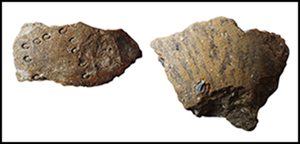Crossref Citations
This article has been cited by the following publications. This list is generated based on data provided by
Crossref.
Sobkowiak-Tabaka, Iwona
Kurzawska, Aldona
Szczepaniak, Małgorzata
Grześkowiak, Marek
Fleszar, Mariusz
Levinzon, Yevhenii
Sokół, Albin
and
Diachenko, Aleksandr
2023.
Shell-tempered ceramics: A case study of Western Tripolye kitchen ware in the Middle Dniester region.
Journal of Archaeological Science: Reports,
Vol. 51,
Issue. ,
p.
104207.
Sebillaud, P.
Duval, P.A.
and
Liu, X.
2023.
Shell-tempered pottery: Opportunism OR/AND technical choice? On the use of a common resource by Northeast China hunter-gatherers.
Journal of Archaeological Science: Reports,
Vol. 51,
Issue. ,
p.
104161.
Lõugas, Lembi
and
Bērziņš, Valdis
2023.
Natural History and Exploitation of the Harbor Porpoise (Phocoena phocoena Linnaeus, 1758) during the Neolithic (ca. 4000–2000 cal. BC) in the Eastern Baltic Region.
Animals,
Vol. 13,
Issue. 5,
p.
909.
Oras, Ester
Tõrv, Mari
Johanson, Kristiina
Rannamäe, Eve
Poska, Anneli
Lõugas, Lembi
Lucquin, Alexandre
Lundy, Jasmine
Brown, Samantha
Chen, Shidong
Varul, Liivi
Haferberga, Vanda
Legzdiņa, Dardega
Zariņa, Gunita
Cramp, Lucy
Heyd, Volker
Reay, Michaela
Pospieszny, Łukasz
Robson, Harry K.
Nordqvist, Kerkko
Heron, Carl
Craig, Oliver E.
and
Kriiska, Aivar
2023.
Parallel worlds and mixed economies: multi-proxy analysis reveals complex subsistence systems at the dawn of early farming in the northeast Baltic.
Royal Society Open Science,
Vol. 10,
Issue. 10,
Chen, Shidong
Johanson, Kristiina
Matthews, John Alphonsus
Sammler, Sandra
Blehner, Marie Anna
Salmar, Siim
Leito, Ivo
and
Oras, Ester
2024.
Multi-proxy analysis of starchy plant consumption: a case study of pottery food crusts from a Late Iron Age settlement at Pada, northeast Estonia.
Vegetation History and Archaeobotany,
Vol. 33,
Issue. 3,
p.
407.
Bērziņš, Valdis
Breijers, Edijs
Kalińska, Edyta
and
Krievāns, Māris
2024.
Shifting Shores and Stone Age Settlement: The Former Ventspils Lagoon Area, Latvia.
Environmental Archaeology,
Vol. 29,
Issue. 6,
p.
528.
Kleijne, J.P.
Bērziņš, V.
Huisman, D.J.
Kalniņš, M.
Krause-Kyora, B.
Meadows, J.
van Os, B.J.H.
Schmölcke, U.
Steinhagen, F.
and
Lübke, H.
2024.
No time to waste. Evidence for communal waste management among hunter-gatherer-fishers at Riņņukalns, Latvia (5400-3200 BC).
Quaternary Environments and Humans,
Vol. 2,
Issue. 1,
p.
100003.
Petřík, Jan
Slavíček, Karel
Adameková, Katarína
Jaques, Victory A. J.
Košťál, Martin
Tóth, Peter
Petr, Libor
Všianský, Dalibor
Zikmund, Tomas
Kaiser, Jozef
Bátora, Jozef
and
Bickle, Penny
2024.
Technology and provenience of the oldest pottery in the northern Pannonian Basin indicates its affiliation to hunter-gatherers.
Scientific Reports,
Vol. 14,
Issue. 1,
Haferberga (Visocka), Vanda
Kons, Artis
and
Bērziņš, Valdis
2024.
Ieskats neolīta podniecības tehnoloģijās Latvijas piejūras teritorijā: Siliņupes un Slocenes apmetņu keramikas analīze.
Arheoloģija un etnogrāfija,
Vol. 33,
Issue. ,
p.
87.
Bērziņš, Valdis
Čakare, Agnese
Kalniņš, Mārcis
Lõugas, Lembi
Mīlgrāve, Ildze
and
Zagorska, Ilga
2024.
Amber wind and porpoise jaw: Resource use at Siliņupe (fourth mill. BC) on the Baltic’s Gulf of Riga Coast.
The Journal of Island and Coastal Archaeology,
Vol. 19,
Issue. 2,
p.
398.
